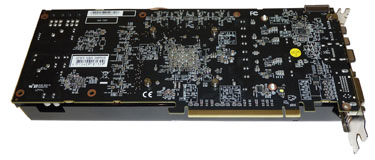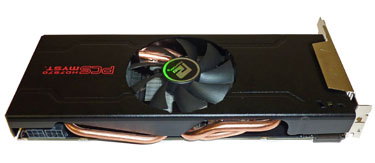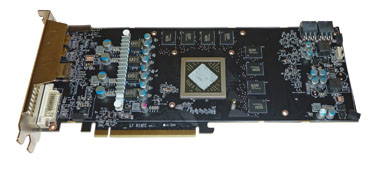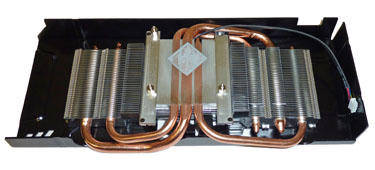Tahiti LE?
AMD's Radeon HD 8000-series desktop GPUs are still some way off, according to numerous reports circulating the web. We believe you won't see cards available until at least February, perhaps even March 2013. And a lack of shiny technology puts add-in card (AIC) partners in a tough spot, frankly. There are only so many special-edition models that the market can take before enthusiasts and gamers no longer take notice. Bucking the usual malaise surrounding the festive season is AMD's decision to allow partners to construct a new GPU - one that fits between the £170 Radeon HD 7870 and £225 Radeon HD 7950.
What's in a name?
This halfway-house card is called the Radeon HD 7870 'Special Edition' and only a few partners will manufacture it. The name suggests that it is a supercharged version of the already-highly-clocked Radeon HD 7870 GPU based on AMD's Pitcairn technology. But this is not the case, as the underlying guts are taken from the meatier Tahiti architecture that powers the Radeon HD 7950/70 GPUs. Confused? You may well be. AMD should really have instructed AICs to call this new GPU the Radeon HD 7930, and we'll explain why by taking a look at its vital statistics.
Trusty Table™ |
|||
|---|---|---|---|
| GPU | Radeon HD 7950 (3,072MB) |
Radeon HD 7870 TLE (2,048MB) |
Radeon HD 7870 (2,048MB) |
| GPU codename | Tahiti Pro | Tahiti LE | Pitcairn XT |
| Architecture | GCN | GCN | GCN |
| Process | 28nm | 28nm | 28nm |
| Transistors | 4.3bn | 4.3bn | 2.8bn |
| Die size | 352mm² | 352mm² | 212mm² |
| Processors | 1,792 | 1,536 | 1,280 |
| Default memory | 3GB | 2GB | 2GB |
| Compute units | 28 | 24 | 20 |
| Texture units | 112 | 96 | 80 |
| ROP units | 32 | 32 | 32 |
| Base GPU Clock (MHz) | 800 | 925 | 1,000 |
| Boost Shader Clock (MHz) | 925 | 975 | NA |
| GFLOPS (inc. Boost) | 3,315 | 2,995 | 2,560 |
| Memory clock (MHz) | 5,000 | 6,000 | 4,800 |
| Memory bus (bits) | 384 | 256 | 256 |
| Max bandwidth (GB/s) | 240 | 192 | 153.6 |
| Power connectors | 6+6 | 6+6 | 6+6 |
| TDP (watts) | 180 | 180 | 175 |
| Current price | £225 | £180 | £170 |
An expensive way to build an upper-mid-range card
This Radeon HD 7870 Tahiti LE (TLE) core crams in the same 4.3bn transistors as the best single-GPU cards from AMD's stable. Each of Tahiti's Compute Units is home to 64 processors. The numbers show the TLE variant to have four fewer CUs than a Radeon HD 7950, leading to a diminution of shaders from 1,792 to 1,536. Appreciate that four texture units accompany each CU and the TLE loses a further 16. Though the raster back-ends are kept the same, the TLE also loses two 64-bit memory controllers, resulting in a 256-bit-wide bus and a standard framebuffer size of 2GB, instead of 384-bit/3GB for HD 7950. The snipping machine has dutifully done its work.
Losing this kind of visceral punch is somewhat offset by increasing the Tahiti core frequency to 925MHz (up to 975MHz through PowerTune with Boost) and memory speed to 6,000MHz. The cards' GFLOPS throughput and memory bandwidth provide a very rough-and-ready indication of overall performance - the trio are all based on the GCN architecture - and we can clearly determine this HD 7870 TLE falls between HD 7870 and HD 7950, though it shares considerably greater architecture similarity to the latter: this is why we remain perplexed by the HD 78xx name.
No matter which way AMD or an AIC partner wishes to refer to this limited-run GPU, it represents an expensive method of constructing a sub-£200 graphics card, because the huge GPU and high-speed memory are intrinsically costlier than the leaner Pitcairn XT GPU powering the standard HD 7870. Common sense suggests AMD is providing partners with excellent silicon buy-in pricing, and keeping costs in check, said partners are most likely repurposing coolers and PCBs used on either the HD 7870 or HD 7950 cards already in the wild.
PowerColor is an AMD partner jumping in on the 7870 TLE act. It is interesting to note that the firm doesn't divulge the GPU provenance anywhere in the product pages. One could easily mistake this card for being a standard HD 7870, a fact that's all the more noisome as the GPU core speed is lower than a vanilla card based on the Pitcairn XT architecture.
Perhaps a play on the nebulous nature of the GPU and card, PowerColor refers to it as the HD 7870 Myst 2GB. The 10.5in PCB matches a Radeon HD 7970's and the muscular cooler covers the board in its entirety. It appears as if PowerColor uses a unique heatsink-and-fan unit for this card; it doesn't appear anywhere else in the various HD 7800/7900 models from the Taiwanese outfit. Digging around further, sister company VTX3D also has an identical-looking card in its ranks.
Most companies rely on two- or three-fan coolers to keep the GPU's temperature at low levels. PowerColor, however, opts for a centrally-mounted, 92mm fan that sits in a U-shaped cutout within the aluminium heatsink. While different from AMD's standard specifications in some respects, the rear IO configuration is generic, encompassing dual-link DVI, HDMI and two mini-DisplayPort outputs. Board power, meanwhile, is supplied by two six-pin PCIe connectors.
An interesting by-product of using a Radeon HD 7900-series GPU rests with the CrossFire ability of the board. This card ties up well with the HD 7950/70 GPUs but cannot be used with the Pitcairn-based HD 7870. Now you see why we think it should be called a Radeon HD 7930. On an unrelated note, the card is one of the first to be compatible with Windows 8 Fast Boot - motherboard permitting - which enables the operating system to load from a cold-boot state in around five seconds.
This is also the first time we've seen a Tahiti-class chip allied to a 256-bit memory interface. Myst uses eight 6.0Gbps chips from Elpida, compared to 12 memory modules on HD 7950/7970 cards. With nothing of major note on the back and plenty of spare PCB space on the front, we're adamant PowerColor could have shortened the card somewhat, especially when you view the actual heatsink, which is only 7.5in wide. The cooling isn't as overtly impressive as, say, the 7870 Vortex II, and we reckon this is the case because PowerColor needs keep the price comfortably below £200.
Costing just a few pounds more than pre-overclocked Radeon HD 7870s yet promising oodles more performance by dint of its Tahiti GPU architecture, the HD 7930 HD 7870 Myst is intriguing on many fronts. Let's now put its mettle to the test.















